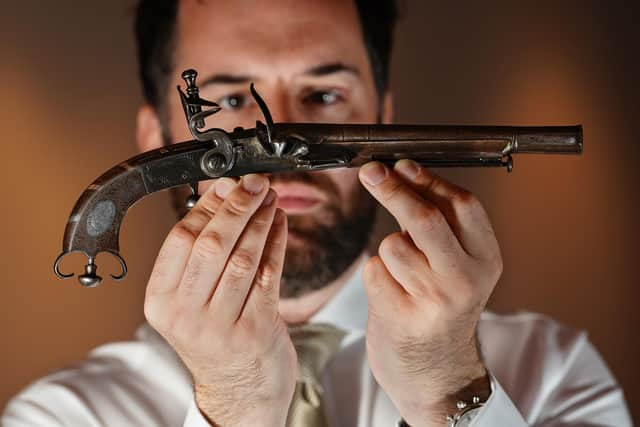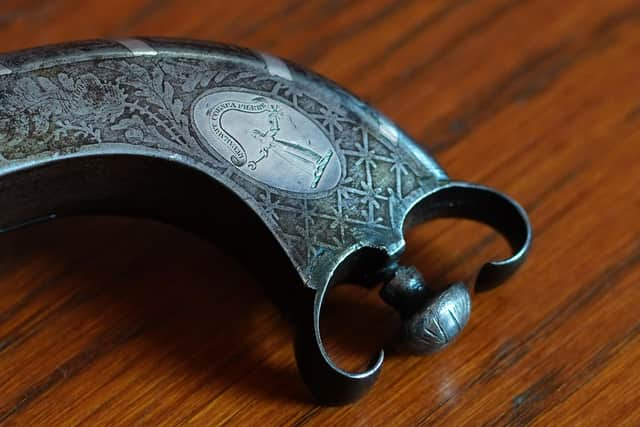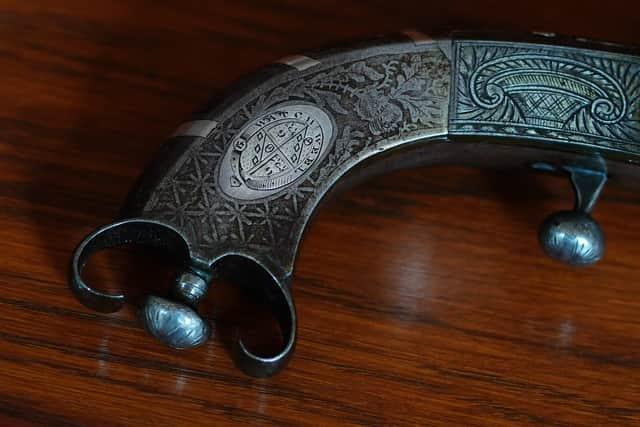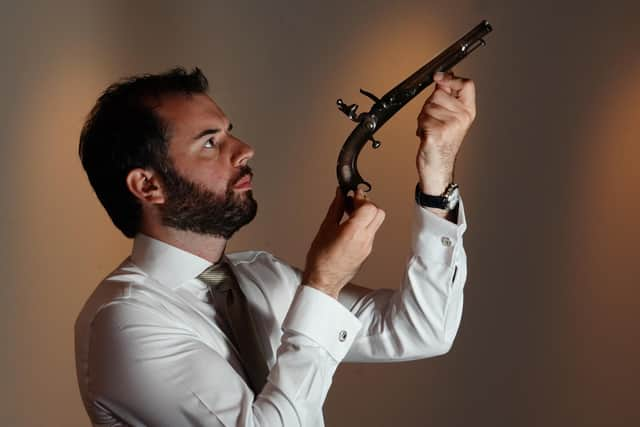Rare pistol made for Sir Walter Scott to go under the hammer
The rare piece is engraved with the Scott of Abbotsford family crest on one side, and a coat of arms with the motto “Watch Weel” on the other.
It will be auctioned by Lyon & Turnbull and sold as part of the Edinburgh-headquartered auction house's Scottish Works and Whisky sale on Wednesday.
It is expected to fetch between £15,000 and £20,000.
Advertisement
Hide AdAdvertisement
Hide AdColin Fraser, specialist in arms and armour at Lyon & Turnbull, said: “This is a remarkable Scottish belt pistol given its connection to Sir Walter Scott, one of the most successful authors of all time.
"The pistol was made by McLeod, the same maker of a pair of pistols, bearing a similar armorial engraving and still within Sir Walter Scott’s collection and on display at Abbotsford.
"Scott actually mentions commissioning the pair for King George IV’s visit to Scotland in 1822 in letters to McLeod.
"Sir Walter Scott organised this Royal visit, which not only had a huge impact on 19th century Scotland, but had a long-lasting effect. It brought the wearing of full Highland dress, broad sword dirks (daggers) and Highland belt pistols, like the type referred to here, back into fashion.”


Today, Sunday, August 15, marks 250 years since Sir Walter Scott was born in Edinburgh.
The anniversary is being marked this weekend by ScottFest at Abbotsford, Scott’s former pile in the Scottish Borders, with the festival of the writer themed around his novel Ivanhoe.
The anniversary is also being marked by The Royal Mint with its first ever commemorative £2 coin.


Scott’s influence on Scottish culture – and how Scottish culture is defined – is immense. He has been credited with popularising tartan, saving the Scottish banknote and rediscovering the nation’s Crown Jewels.
Advertisement
Hide AdAdvertisement
Hide AdHis string of bestsellers, such as the Waverley series of historical novels, dominated the 19th century and changed how the world saw Scotland and Scotland saw itself.
There was an unquenchable thirst for his work. More than 23,000 copies of his poem Lady of the Lake, which the writer set around Loch Katrine and the Trossachs, were sold.
It was a literary phenomenon of its time – with the image of romantic Scotland sold along with the verse, which has been credited with kick-starting the Scottish tourism industry.


The speed of publishing Scott’s work to keep up with demand – combined with his notoriously spidery handwriting – meant many errors occurred as they made their way into print.
This anniversary year, a major project is being undertaken at Aberdeen University to correct Scott’s poems and create the first half of a complete edition of verse, which will span ten volumes in time.
The Walter Scott Research Centre at the university now aims to return his poetry to a form that more closely reflects the writer’s original intentions and include his long notes on characters, time and place for context for the reader.
The centre has also launched an online exhibition to introduce a “lesser known Scott” and his love of music to the public.
The exhibition explores the ‘Wizard of the North’s’ legacy in terms of folk song, opera and theatre, from the ballads he collected to popular songs such as Bonnie Dundee.
Advertisement
Hide AdAdvertisement
Hide AdA Tribute to Sir Walter Scott planned for Aberdeen’s Machar Cathedral on 28 August, featuring jazz pianist Neil Birse, guitarist Tom Williams and singer Katie Mackie, among others.


A message from the Editor:Thank you for reading this article. We're more reliant on your support than ever as the shift in consumer habits brought about by coronavirus impacts our advertisers.
If you haven't already, please consider supporting our trusted, fact-checked journalism by taking out a digital subscription.
Comments
Want to join the conversation? Please or to comment on this article.
